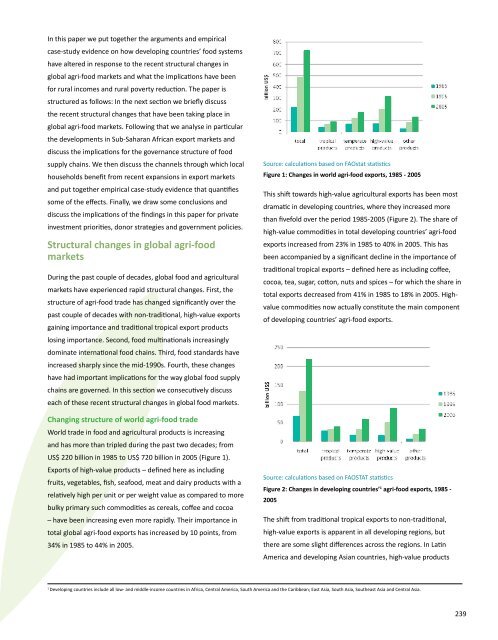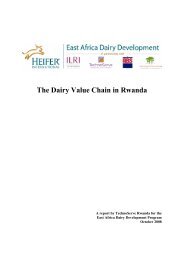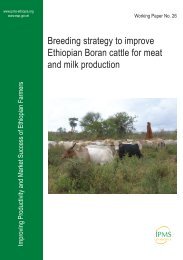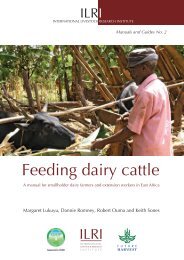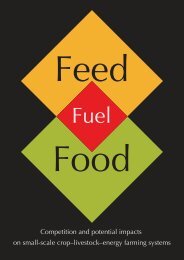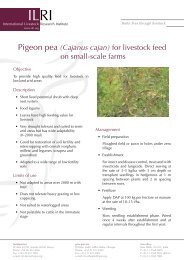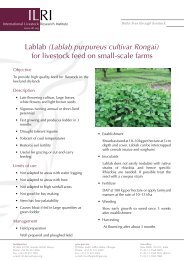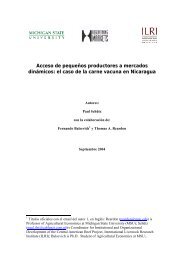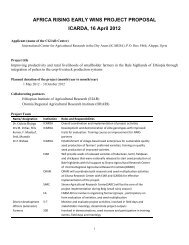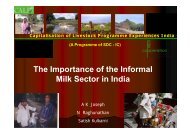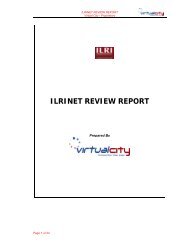High-Value Commodities and Agroprocessing - International ...
High-Value Commodities and Agroprocessing - International ...
High-Value Commodities and Agroprocessing - International ...
You also want an ePaper? Increase the reach of your titles
YUMPU automatically turns print PDFs into web optimized ePapers that Google loves.
In this paper we put together the arguments <strong>and</strong> empirical<br />
case-study evidence on how developing countries’ food systems<br />
have altered in response to the recent structural changes in<br />
global agri-food markets <strong>and</strong> what the implications have been<br />
for rural incomes <strong>and</strong> rural poverty reduction. The paper is<br />
structured as follows: In the next section we briefly discuss<br />
the recent structural changes that have been taking place in<br />
global agri-food markets. Following that we analyse in particular<br />
the developments in Sub-Saharan African export markets <strong>and</strong><br />
discuss the implications for the governance structure of food<br />
supply chains. We then discuss the channels through which local<br />
households benefit from recent expansions in export markets<br />
<strong>and</strong> put together empirical case-study evidence that quantifies<br />
some of the effects. Finally, we draw some conclusions <strong>and</strong><br />
discuss the implications of the findings in this paper for private<br />
investment priorities, donor strategies <strong>and</strong> government policies.<br />
Structural changes in global agri-food<br />
markets<br />
During the past couple of decades, global food <strong>and</strong> agricultural<br />
markets have experienced rapid structural changes. First, the<br />
structure of agri-food trade has changed significantly over the<br />
past couple of decades with non-traditional, high-value exports<br />
gaining importance <strong>and</strong> traditional tropical export products<br />
losing importance. Second, food multinationals increasingly<br />
dominate international food chains. Third, food st<strong>and</strong>ards have<br />
increased sharply since the mid-1990s. Fourth, these changes<br />
have had important implications for the way global food supply<br />
chains are governed. In this section we consecutively discuss<br />
each of these recent structural changes in global food markets.<br />
Changing structure of world agri-food trade<br />
World trade in food <strong>and</strong> agricultural products is increasing<br />
<strong>and</strong> has more than tripled during the past two decades; from<br />
US$ 220 billion in 1985 to US$ 720 billion in 2005 (Figure 1).<br />
Exports of high-value products – defined here as including<br />
fruits, vegetables, fish, seafood, meat <strong>and</strong> dairy products with a<br />
relatively high per unit or per weight value as compared to more<br />
bulky primary such commodities as cereals, coffee <strong>and</strong> cocoa<br />
– have been increasing even more rapidly. Their importance in<br />
total global agri-food exports has increased by 10 points, from<br />
34% in 1985 to 44% in 2005.<br />
Source: calculations based on FAOstat statistics<br />
Figure 1: Changes in world agri-food exports, 1985 - 2005<br />
This shift towards high-value agricultural exports has been most<br />
dramatic in developing countries, where they increased more<br />
than fivefold over the period 1985-2005 (Figure 2). The share of<br />
high-value commodities in total developing countries’ agri-food<br />
exports increased from 23% in 1985 to 40% in 2005. This has<br />
been accompanied by a significant decline in the importance of<br />
traditional tropical exports – defined here as including coffee,<br />
cocoa, tea, sugar, cotton, nuts <strong>and</strong> spices – for which the share in<br />
total exports decreased from 41% in 1985 to 18% in 2005. <strong>High</strong>value<br />
commodities now actually constitute the main component<br />
of developing countries’ agri-food exports.<br />
Source: calculations based on FAOSTAT statistics<br />
Figure 2: Changes in developing countries’ 1 agri-food exports, 1985 -<br />
2005<br />
The shift from traditional tropical exports to non-traditional,<br />
high-value exports is apparent in all developing regions, but<br />
there are some slight differences across the regions. In Latin<br />
America <strong>and</strong> developing Asian countries, high-value products<br />
1 Developing countries include all low- <strong>and</strong> middle-income countries in Africa, Central America, South America <strong>and</strong> the Caribbean; East Asia, South Asia, Southeast Asia <strong>and</strong> Central Asia.<br />
239


